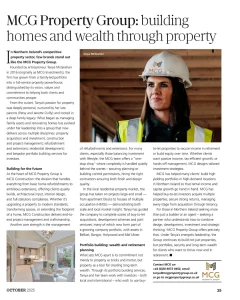Like many developers and builders, we have been analysing price movement in our materials over the past two years, as we attempt to get a handle on why our like-for-like project costs are coming out 20%-25% higher for reasonably similar repeat scope and repeat specification. We have noted sizeable increases in a range of vital materials for house building including steel, cladding, timber, cement, glass, and insulation. This is due to a number of factors including the pandemic, Brexit, supply chain disruption, the shortage of labour, in particular HGV drivers, and the continued rise in demand for new homes. The knock-on effect of these factors is very concerning, as it could potentially impact the recovery of the construction and property industry.
We have recently acquired a site with full planning permission for an apartment development scheme, in a joint venture with another developer and whilst the prospect of moving in to new build residential schemes really excites us, we do have to be careful in this climate to ensure we carry out extensive due diligence and stress test all our schemes to make sure they remain viable. That includes assessing building costs per square foot and selling costs per square foot to make sure that we can cover any further unforeseen material cost rises and all contingencies, as best as we possibly can.
It is not just the rise in material costs that are causing practical challenges for the industry. “Whilst there is a lot of talk about material costs rising, the other major impact for the construction industry at present is the lead times for the delivery of key building materials such as windows. Pre-pandemic, we could measure, order and install windows for a project in approximately four to six weeks. That process is now taking more than 12 weeks due to labour shortages, transport and logistics challenges. Such delays add to our project delivery timeframe taking longer to bring our houses to market.
However, as we move into 2022 we believe that these issues will settle.
As we move into the last quarter of 2021 we are cautiously optimistic that the latter part of the year will bring some stability to construction costs and enable accurate financial planning for the industry and within our own business. We currently have over £4m worth of live property projects on our books and have bought properties for both MCG Investments and our clients, at prices that allow us to have more than one exit strategy when the projects are complete. We buy, improve and re-sell and we also buy, improve and hold for the longer term. Both strategies are proving popular for clients at the moment depending on their preferred investment approach.
We are continuing to invest in the local residential property market and have exciting plans to expand further in 2022 with the benefit of hopefully more settled industry construction conditions.







